Pea Milk Market
Pea Milk Market Size and Share Forecast Outlook 2025 to 2035
Pea milk market is projected to grow from USD 520.0 million in 2025 to USD 1,122.6 million by 2035, at a CAGR of 8.0%. Original/Unsweetened will dominate with a 46.0% market share, while retail will lead the distribution channel segment with a 64.0% share.
Pea Milk Market Forecast and Outlook 2025 to 2035
The global pea milk market is valued at USD 520 million in 2025. It is slated to reach USD 1,122.6 million by 2035, recording an absolute increase of USD 600 million over the forecast period. This translates into a total growth of 115.4%, with the market forecast to expand at a compound annual growth rate (CAGR) of 8% between 2025 and 2035.
The overall market size is expected to grow by nearly 2.15X during the same period, supported by increasing plant-based diet adoption, growing environmental consciousness, rising dairy intolerance awareness, and expanding availability through mainstream retail channels.
Quick Stats for Pea Milk Market
- Pea Milk Market Value (2025): USD 520 million
- Pea Milk Market Forecast Value (2035): USD 1,122.6 million
- Pea Milk Market Forecast CAGR: 8%
- Leading Type in Pea Milk Market: Original/Unsweetened
- Key Growth Regions in Pea Milk Market: North America, Europe, and Asia-Pacific
- Key Players in Pea Milk Market: Ripple Foods, Danone Alpro, Nestlé, Califia Farms, Dream, Sproud
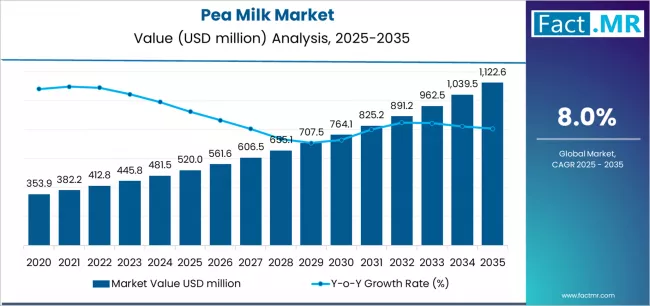
Between 2025 and 2030, the pea milk market is projected to expand from USD 520 million to USD 780 million, resulting in a value increase of USD 260 million, which represents 43.3% of the total forecast growth for the decade. This phase of development will be shaped by increasing mainstream retail penetration, growing protein-focused nutrition trends, and expanding product innovations in taste and nutritional enhancement. Plant-based beverage manufacturers and dairy alternatives companies are expanding their pea milk capabilities to address the growing demand for sustainable and nutritious dairy alternatives.
Pea Milk Market Key Takeaways
| Metric | Value |
|---|---|
| Estimated Value in (2025E) | USD 520 million |
| Forecast Value in (2035F) | USD 1,122.6 million |
| Forecast CAGR (2025 to 2035) | 8% |
From 2030 to 2035, the market is forecast to grow from USD 780 million to USD 1,120 million, adding another USD 340 million, which constitutes 56.7% of the overall ten-year expansion. This period is expected to be characterized by the expansion of functional pea milk formulations, development of premium organic offerings, and growth of barista and professional applications. The growing adoption of personalized nutrition approaches and sustainable consumption patterns will drive demand for pea milk with enhanced protein content and specialized nutritional profiles.
Between 2020 and 2025, the pea milk market experienced significant growth, driven by increasing consumer awareness of plant-based nutrition benefits and growing recognition of pea milk as a superior dairy alternative with high protein content and minimal environmental impact. The market developed as health-conscious consumers and environmentally aware individuals recognized the potential for pea milk to provide complete nutrition, support dietary restrictions, and deliver sustainable consumption while maintaining taste satisfaction and nutritional adequacy.
Why is the Pea Milk Market Growing?
Market expansion is being supported by the increasing consumer shift toward plant-based nutrition driven by health consciousness and environmental sustainability concerns, alongside the corresponding need for high-protein dairy alternatives that can provide complete nutrition, support muscle health, and ensure comprehensive dietary adequacy across various consumer demographics and lifestyle applications. Modern plant-based beverage companies and dairy alternative manufacturers are increasingly focused on implementing pea milk solutions that can meet protein requirements, support sustainable consumption, and provide nutritional benefits while maintaining taste appeal and consumer satisfaction.
The growing emphasis on protein nutrition and fitness culture is driving demand for pea milk that can support muscle building, weight management, and ensure comprehensive protein intake through plant-based sources with complete amino acid profiles. Beverage manufacturers' preference for ingredients that combine nutritional superiority with environmental benefits and market differentiation is creating opportunities for innovative pea milk implementations. The rising influence of dairy intolerance awareness and allergen-free nutrition is also contributing to increased adoption of pea milk that can provide superior nutritional benefits without compromising digestive comfort or dietary compliance.
Segmental Analysis
The market is segmented by type, distribution channel, and packaging. By type, the market is divided into original/unsweetened, flavored, and barista/protein+. Based on distribution channel, the market is categorized into retail, online, and foodservice. By packaging, the market is segmented into aseptic cartons, PET, and others.
By Type, the Original/Unsweetened Segment Leads the Market

The original/unsweetened segment is projected to maintain its leading position in the pea milk market in 2025 with a 46% market share, reaffirming its role as the preferred variant for health-conscious consumers seeking clean-label and versatile dairy alternatives. Plant-based beverage manufacturers and health-focused consumers increasingly utilize original/unsweetened pea milk for their pure nutritional profiles, versatile application capabilities, and proven effectiveness in providing protein benefits while maintaining ingredient transparency and dietary flexibility. Original/unsweetened formulation's proven effectiveness and consumer preference directly address market requirements for clean nutrition and application versatility across diverse consumption occasions and dietary needs.
This type segment forms the foundation of modern plant-based milk consumption, as it represents the variant with the greatest contribution to nutritional authenticity and established consumer trust across multiple application categories and health-conscious consumer segments. Plant-based beverage industry investments in pure formulation technologies continue to strengthen adoption among manufacturers and nutrition-focused consumers. With consumer preferences requiring clean ingredients and nutritional transparency, original/unsweetened pea milk aligns with both health objectives and clean-label requirements, making it the central component of comprehensive plant-based nutrition strategies.
By Distribution Channel, the Retail Segment Dominates Market Demand

The retail distribution channel is projected to represent the largest share of pea milk demand in 2025 with a 64% market share, underscoring its critical role as the primary avenue for pea milk sales across supermarkets, health stores, and specialty retailers. Consumers prefer retail channels for pea milk purchases due to their convenient accessibility, product variety, and proven effectiveness in providing consistent availability while supporting routine shopping patterns and household stocking requirements. Positioned as essential channels for plant-based beverage distribution, retail offers both convenience and product discovery advantages.
The segment is supported by continuous expansion in retail placement and the growing availability of dedicated plant-based sections that enable superior product visibility with enhanced consumer education and purchase conversion. Retailers are investing in comprehensive plant-based beverage merchandising programs to support increasingly diverse pea milk offerings and consumer demand for dairy alternative options. As plant-based consumption increases and retail sophistication advances, the retail channel will continue to dominate the market while supporting advanced merchandising strategies and consumer accessibility optimization.
What are the Drivers, Restraints, and Key Trends of the Pea Milk Market?
The pea milk market is advancing rapidly due to increasing consumer adoption of plant-based diets driven by health consciousness and environmental awareness, alongside growing demand for high-protein dairy alternatives that provide complete nutrition, support fitness goals, and ensure comprehensive dietary adequacy while addressing lactose intolerance and allergen concerns across various consumer demographics. However, the market faces challenges, including taste acceptance barriers compared to traditional dairy milk, higher retail prices than conventional milk alternatives, and limited consumer awareness of pea milk benefits among mainstream audiences. Innovation in taste optimization and consumer education continues to influence market acceptance and expansion patterns.
Expansion of Protein-Focused Nutrition and Fitness Trends
The growing emphasis on protein nutrition is driving demand for pea milk that can support muscle building, athletic performance, and weight management through high-quality plant protein with complete amino acid profiles that rival traditional dairy protein sources. Fitness-conscious consumers require advanced pea milk formulations that deliver superior protein benefits across multiple nutritional parameters while maintaining taste satisfaction and convenient consumption. Health brands are increasingly recognizing the competitive advantages of pea milk positioning for protein markets and athletic nutrition applications, creating opportunities for specialized products designed for fitness enthusiasts and protein-conscious consumer segments.
Integration of Environmental Sustainability and Carbon Footprint Reduction
Modern pea milk manufacturers are incorporating sustainability messaging and environmental benefit positioning to enhance market appeal, attract environmentally conscious consumers, and support comprehensive sustainability objectives through reduced carbon footprint and water usage compared to traditional dairy production. Leading companies are developing carbon-neutral production methods, implementing sustainable packaging solutions, and advancing supply chain practices that minimize environmental impact while maintaining product quality. These initiatives improve environmental credentials while enabling market differentiation opportunities, including eco-conscious consumer segments, sustainability-focused retailers, and corporate responsibility programs.
Development of Functional and Specialized Formulations
The expansion of functional food markets and specialized nutrition applications is driving demand for enhanced pea milk products with added vitamins, minerals, probiotics, and specialized nutritional compounds that address specific health objectives and consumer needs. These functional applications require advanced formulation capabilities and nutritional enhancement systems that exceed basic plant milk production requirements, creating premium market segments with differentiated value propositions. Manufacturers are investing in functional ingredient integration and specialized formulation development to serve emerging health applications while supporting innovation in personalized nutrition and targeted wellness solutions.
Analysis of the Pea Milk Market by Key Countries
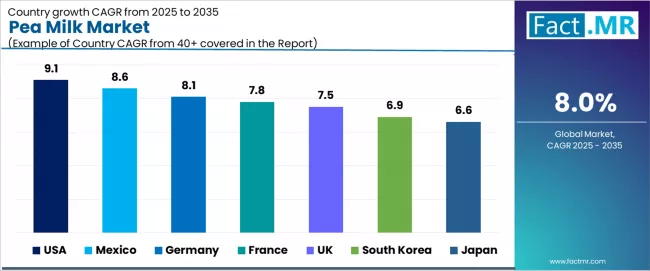
| Country | CAGR (2025-2035) |
|---|---|
| USA | 9.1% |
| Mexico | 8.6% |
| Germany | 8.1% |
| France | 7.8% |
| UK | 7.5% |
| South Korea | 6.9% |
| Japan | 6.6% |
The pea milk market is experiencing robust growth globally, with the USA leading at a 9.1% CAGR through 2035, driven by extensive plant-based movement, advanced protein consciousness, and well-established dairy alternative market supporting pea milk innovation. Mexico follows at 8.6%, supported by growing health awareness, expanding plant-based food culture, and increasing availability of alternative protein sources. Germany shows growth at 8.1%, emphasizing environmental sustainability, health consciousness, and advanced plant-based product development. France demonstrates 7.8% growth, supported by health-focused consumers, environmental awareness, and premium plant-based beverage appreciation. The UK records 7.5%, focusing on plant-based lifestyle adoption, environmental consciousness, and dairy alternative innovation. South Korea exhibits 6.9% growth, emphasizing health optimization and premium nutrition products. Japan shows 6.6% growth, supported by health consciousness and quality plant-based beverage preferences.
USA Leads Global Market Growth with Plant-Based Innovation
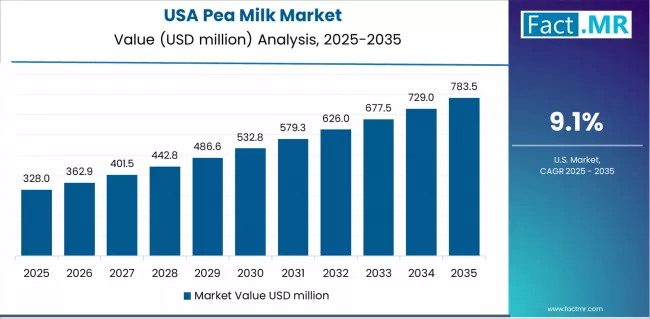
Revenue from pea milk in the USA is projected to exhibit exceptional growth with a CAGR of 9.1% through 2035, driven by extensive plant-based movement development and rapidly growing protein consciousness supporting pea milk adoption among health enthusiasts, athletes, and environmentally conscious consumers. The country's advanced plant-based beverage market and increasing consumer interest in high-protein alternatives are creating substantial demand for pea milk solutions. Major plant-based companies and beverage manufacturers are establishing comprehensive product development capabilities to serve both domestic markets and export opportunities.
- Strong plant-based movement and protein nutrition trends are driving demand for pea milk throughout health stores, fitness retailers, and mainstream supermarkets across urban markets, fitness communities, and health-conscious consumer segments.
- Growing environmental consciousness and dairy alternative adoption are supporting the rapid development of innovative pea milk formulations among companies seeking nutritional advantages and competitive positioning in the expanding plant-based beverage market.
Mexico Demonstrates Strong Market Potential with Health Awareness Growth
Revenue from pea milk in Mexico is expanding at a CAGR of 8.6%, supported by the country's growing health awareness, expanding plant-based food culture, and increasing consumer interest in alternative protein sources and sustainable nutrition options. The country's evolving health consciousness and wellness trends are driving demand for nutritious pea milk products throughout urban centers and health-focused communities. Leading plant-based brands and beverage companies are establishing comprehensive distribution networks to address growing demand for dairy alternatives.
- Rising health consciousness and expanding wellness culture are creating opportunities for pea milk adoption across health stores, supermarkets, and online platforms in major urban markets and health-focused consumer segments.
- Growing plant-based food awareness and protein nutrition interest are driving adoption of pea milk products among consumers seeking high-protein dairy alternatives and sustainable nutrition solutions for active lifestyles.
Germany Demonstrates Sustainability Excellence with Environmental Focus
Revenue from pea milk in Germany is expanding at a CAGR of 8.1%, driven by the country's emphasis on environmental sustainability, health consciousness, and comprehensive approach to plant-based nutrition supporting evidence-based pea milk development. Germany's environmental awareness and sustainable consumption focus are driving demand for eco-friendly pea milk solutions. Leading sustainability-focused companies and plant-based manufacturers are establishing comprehensive innovation programs for environmentally responsible beverage development.
- Advanced environmental consciousness and consumer preference for sustainable products are creating demand for pea milk products among environmentally aware consumers seeking reduced carbon footprint and sustainable nutrition alternatives.
- Strong sustainability emphasis and plant-based nutrition trends are supporting the adoption of certified pea milk formulations across organic retailers, health stores, and sustainability-focused consumer markets throughout major urban regions.
France Focuses on Health Innovation and Premium Applications
Revenue from pea milk in France is expanding at a CAGR of 7.8%, driven by the country's health-focused consumer base, environmental awareness, and comprehensive approach to premium plant-based beverages supporting pea milk integration into sophisticated nutrition routines. France's health culture and premium positioning preferences are supporting investment in advanced pea milk technologies. Major health brands and premium beverage companies are establishing comprehensive innovation programs incorporating pea milk with French wellness approaches.
- Advanced health consciousness and consumer preference for premium nutrition products are creating demand for high-quality pea milk throughout specialty retailers, health stores, and premium grocery outlets serving health-focused consumer segments.
- Strong environmental awareness and premium beverage culture are driving the adoption of artisanal pea milk applications meeting high quality standards and sophisticated nutritional preferences across diverse wellness applications.
UK Shows Market Leadership with Plant-Based Lifestyle Integration
Revenue from pea milk in the UK is expanding at a CAGR of 7.5%, supported by the country's extensive plant-based lifestyle adoption, environmental consciousness, and growing interest in dairy alternatives and sustainable nutrition supporting pea milk adoption across diverse consumer segments. The UK's plant-based culture and sustainability focus are driving demand for innovative pea milk solutions. Leading plant-based brands and sustainable beverage companies are investing in product innovation and consumer education for dairy alternative markets.
- Advanced plant-based lifestyle adoption and consumer interest in environmental sustainability are creating opportunities for pea milk products throughout health retailers, supermarkets, and specialty stores serving environmentally conscious consumer segments.
- Strong dairy alternative trends and sustainability awareness are driving the adoption of pea milk formulations across mainstream retail channels, online platforms, and specialty retailers targeting plant-based and environmentally conscious consumers.
South Korea Demonstrates Health Leadership with Premium Nutrition Focus
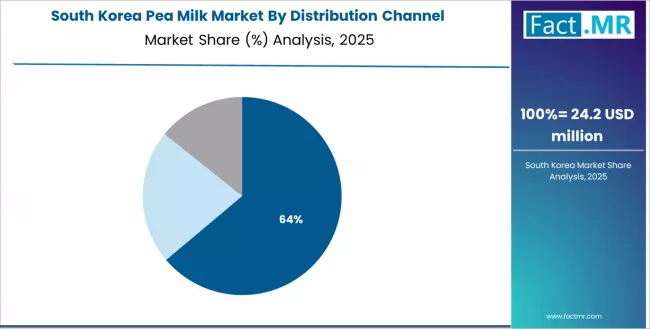
Revenue from pea milk in South Korea is expanding at a CAGR of 6.9%, supported by the country's health optimization culture, premium nutrition market, and strong emphasis on wellness products and functional beverages supporting sophisticated pea milk utilization. The nation's health consciousness and premium positioning trends are driving demand for advanced pea milk solutions. Leading health companies are investing extensively in premium product development and nutrition market expansion.
- Advanced health optimization culture and premium nutrition demand are creating demand for pea milk products throughout health stores, wellness centers, and premium retailers serving health-conscious and fitness-oriented consumer segments.
- Strong wellness focus and functional beverage trends are supporting the adoption of pea milk formulations designed for protein nutrition, fitness support, and overall health optimization across diverse consumer demographics.
Japan Shows Premium Focus with Health and Quality Applications
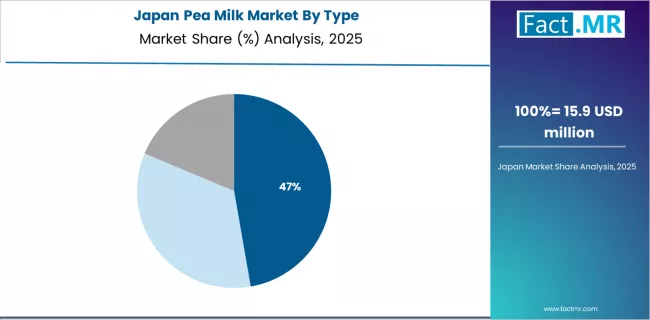
Revenue from pea milk in Japan is expanding at a CAGR of 6.6%, supported by the country's health consciousness, quality beverage preferences, and strong emphasis on nutritional excellence and wellness supporting pea milk adoption for health maintenance and protein supplementation. Japan's health culture and quality focus are driving demand for premium pea milk products. Leading health companies are investing in specialized capabilities for nutritional beverage applications and health-focused product development.
- Advanced health consciousness and quality beverage focus are creating opportunities for pea milk products throughout health stores, premium retailers, and specialty beverage outlets serving health-conscious consumers seeking nutritional excellence.
- Strong quality standards and health focus are driving adoption of premium pea milk formulations meeting Japanese consumer expectations for purity, nutritional density, and comprehensive health benefits across diverse wellness applications.
Europe Market Split by Country
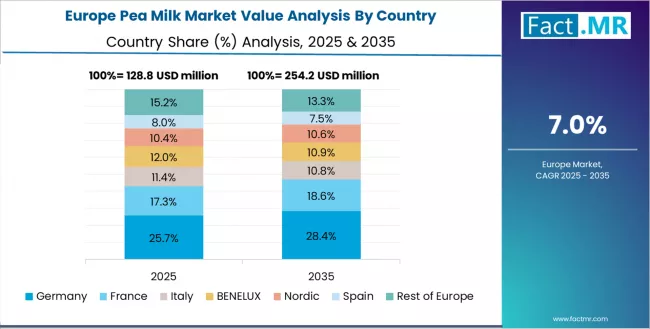
The pea milk market in Europe is projected to grow from USD 150 million in 2025 to USD 315 million by 2035, registering a CAGR of 7.7% over the forecast period. Germany is expected to maintain leadership with a 32% market share in 2025, moderating to 31.7% by 2035, supported by environmental sustainability emphasis, health consciousness, and advanced plant-based product development.
France follows with 25.3% in 2025, projected to reach 25.6% by 2035, driven by health-focused consumer base, environmental awareness, and premium plant-based beverage appreciation. The United Kingdom holds 23.3% in 2025, expected to reach 23.5% by 2035 due to extensive plant-based lifestyle adoption and dairy alternative innovation. Italy commands 11.3% in 2025, rising to 11.4% by 2035, while Spain accounts for 6% in 2025, reaching 6.1% by 2035. The Rest of Europe region is anticipated to hold 2.1% in 2025 and 1.7% by 2035, reflecting steady plant-based beverage adoption in Nordic countries and emerging sustainable nutrition markets in Eastern European countries.
Competitive Landscape of the Pea Milk Market
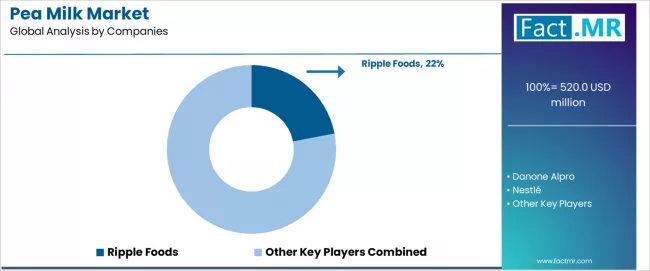
The pea milk market is characterized by competition among established plant-based companies, dairy alternative specialists, and innovative beverage startups. Companies are investing in taste optimization development, nutritional enhancement research, production scaling capabilities, and retail partnership expansion to deliver creamy, nutritious, and accessible pea milk solutions. Innovation in protein extraction, taste improvement, and functional formulation is central to strengthening market position and competitive advantage.
Ripple Foods leads the market with a 22% share, offering comprehensive pea milk solutions with focus on protein nutrition, taste optimization, and extensive retail distribution serving health-conscious consumers and plant-based lifestyle adopters. The company continues investing in research and development while expanding production capacity and retail partnerships. Danone Alpro provides European market leadership with emphasis on sustainability and mainstream accessibility. Nestlé offers global reach with premium positioning and nutritional enhancement. Califia Farms focuses on premium plant-based beverages with innovative packaging. Dream emphasizes affordability and mainstream market penetration. Sproud specializes in European markets with sustainability messaging.
Key Players in the Pea Milk Market
- Ripple Foods
- Danone Alpro
- Nestlé
- Califia Farms
- Dream
- Sproud
- Vitasoy
- Pacific Foods
- Elmhurst
- Good Karma
Scope of the Report
| Items | Values |
|---|---|
| Quantitative Units (2025) | USD 520 million |
| Type | Original/Unsweetened, Flavored, Barista/Protein+ |
| Distribution Channel | Retail, Online, Foodservice |
| Packaging | Aseptic Cartons, PET, Others |
| Regions Covered | North America, Europe, Asia-Pacific, Latin America, Middle East & Africa |
| Countries Covered | USA, Mexico, Germany, France, UK, Japan, South Korea, and 40+ countries |
| Key Companies Profiled | Ripple Foods, Danone Alpro, Nestlé, Califia Farms, Dream, Sproud |
| Additional Attributes | Dollar sales by type and distribution channel, regional demand trends, competitive landscape, technological advancements in pea protein extraction, taste optimization development, nutritional enhancement innovation, and sustainability positioning |
Pea Milk Market by Segments
-
Type :
- Original/Unsweetened
- Flavored
- Barista/Protein+
-
Distribution Channel :
- Retail
- Online
- Foodservice
-
Packaging :
- Aseptic Cartons
- PET
- Others
-
Region :
- North America
- United States
- Canada
- Mexico
- Europe
- Germany
- United Kingdom
- France
- Italy
- Spain
- Netherlands
- Rest of Europe
- Asia-Pacific
- Japan
- South Korea
- China
- India
- Australia
- Rest of Asia-Pacific
- Latin America
- Brazil
- Argentina
- Rest of Latin America
- Middle East & Africa
- Kingdom of Saudi Arabia
- South Africa
- Rest of Middle East & Africa
- North America
Table of Content
- Executive Summary
- Global Market Outlook
- Demand to side Trends
- Supply to side Trends
- Technology Roadmap Analysis
- Analysis and Recommendations
- Market Overview
- Market Coverage / Taxonomy
- Market Definition / Scope / Limitations
- Market Background
- Market Dynamics
- Drivers
- Restraints
- Opportunity
- Trends
- Scenario Forecast
- Demand in Optimistic Scenario
- Demand in Likely Scenario
- Demand in Conservative Scenario
- Opportunity Map Analysis
- Product Life Cycle Analysis
- Supply Chain Analysis
- Investment Feasibility Matrix
- Value Chain Analysis
- PESTLE and Porter’s Analysis
- Regulatory Landscape
- Regional Parent Market Outlook
- Production and Consumption Statistics
- Import and Export Statistics
- Market Dynamics
- Global Market Analysis 2020 to 2024 and Forecast, 2025 to 2035
- Historical Market Size Value (USD Million) Analysis, 2020 to 2024
- Current and Future Market Size Value (USD Million) Projections, 2025 to 2035
- Y to o to Y Growth Trend Analysis
- Absolute $ Opportunity Analysis
- Global Market Pricing Analysis 2020 to 2024 and Forecast 2025 to 2035
- Global Market Analysis 2020 to 2024 and Forecast 2025 to 2035, By Type
- Introduction / Key Findings
- Historical Market Size Value (USD Million) Analysis By Type , 2020 to 2024
- Current and Future Market Size Value (USD Million) Analysis and Forecast By Type , 2025 to 2035
- Original/Unsweetened
- Flavored
- Barista/Protein+
- Y to o to Y Growth Trend Analysis By Type , 2020 to 2024
- Absolute $ Opportunity Analysis By Type , 2025 to 2035
- Global Market Analysis 2020 to 2024 and Forecast 2025 to 2035, By Distribution Channel
- Introduction / Key Findings
- Historical Market Size Value (USD Million) Analysis By Distribution Channel, 2020 to 2024
- Current and Future Market Size Value (USD Million) Analysis and Forecast By Distribution Channel, 2025 to 2035
- Retail
- Online
- Foodservice
- Y to o to Y Growth Trend Analysis By Distribution Channel, 2020 to 2024
- Absolute $ Opportunity Analysis By Distribution Channel, 2025 to 2035
- Global Market Analysis 2020 to 2024 and Forecast 2025 to 2035, By Region
- Introduction
- Historical Market Size Value (USD Million) Analysis By Region, 2020 to 2024
- Current Market Size Value (USD Million) Analysis and Forecast By Region, 2025 to 2035
- North America
- Latin America
- Western Europe
- Eastern Europe
- East Asia
- South Asia and Pacific
- Middle East & Africa
- Market Attractiveness Analysis By Region
- North America Market Analysis 2020 to 2024 and Forecast 2025 to 2035, By Country
- Historical Market Size Value (USD Million) Trend Analysis By Market Taxonomy, 2020 to 2024
- Market Size Value (USD Million) Forecast By Market Taxonomy, 2025 to 2035
- By Country
- USA
- Canada
- Mexico
- By Type
- By Distribution Channel
- By Country
- Market Attractiveness Analysis
- By Country
- By Type
- By Distribution Channel
- Key Takeaways
- Latin America Market Analysis 2020 to 2024 and Forecast 2025 to 2035, By Country
- Historical Market Size Value (USD Million) Trend Analysis By Market Taxonomy, 2020 to 2024
- Market Size Value (USD Million) Forecast By Market Taxonomy, 2025 to 2035
- By Country
- Brazil
- Chile
- Rest of Latin America
- By Type
- By Distribution Channel
- By Country
- Market Attractiveness Analysis
- By Country
- By Type
- By Distribution Channel
- Key Takeaways
- Western Europe Market Analysis 2020 to 2024 and Forecast 2025 to 2035, By Country
- Historical Market Size Value (USD Million) Trend Analysis By Market Taxonomy, 2020 to 2024
- Market Size Value (USD Million) Forecast By Market Taxonomy, 2025 to 2035
- By Country
- Germany
- UK
- Italy
- Spain
- France
- Nordic
- BENELUX
- Rest of Western Europe
- By Type
- By Distribution Channel
- By Country
- Market Attractiveness Analysis
- By Country
- By Type
- By Distribution Channel
- Key Takeaways
- Eastern Europe Market Analysis 2020 to 2024 and Forecast 2025 to 2035, By Country
- Historical Market Size Value (USD Million) Trend Analysis By Market Taxonomy, 2020 to 2024
- Market Size Value (USD Million) Forecast By Market Taxonomy, 2025 to 2035
- By Country
- Russia
- Poland
- Hungary
- Balkan & Baltic
- Rest of Eastern Europe
- By Type
- By Distribution Channel
- By Country
- Market Attractiveness Analysis
- By Country
- By Type
- By Distribution Channel
- Key Takeaways
- East Asia Market Analysis 2020 to 2024 and Forecast 2025 to 2035, By Country
- Historical Market Size Value (USD Million) Trend Analysis By Market Taxonomy, 2020 to 2024
- Market Size Value (USD Million) Forecast By Market Taxonomy, 2025 to 2035
- By Country
- China
- Japan
- South Korea
- By Type
- By Distribution Channel
- By Country
- Market Attractiveness Analysis
- By Country
- By Type
- By Distribution Channel
- Key Takeaways
- South Asia and Pacific Market Analysis 2020 to 2024 and Forecast 2025 to 2035, By Country
- Historical Market Size Value (USD Million) Trend Analysis By Market Taxonomy, 2020 to 2024
- Market Size Value (USD Million) Forecast By Market Taxonomy, 2025 to 2035
- By Country
- India
- ASEAN
- Australia & New Zealand
- Rest of South Asia and Pacific
- By Type
- By Distribution Channel
- By Country
- Market Attractiveness Analysis
- By Country
- By Type
- By Distribution Channel
- Key Takeaways
- Middle East & Africa Market Analysis 2020 to 2024 and Forecast 2025 to 2035, By Country
- Historical Market Size Value (USD Million) Trend Analysis By Market Taxonomy, 2020 to 2024
- Market Size Value (USD Million) Forecast By Market Taxonomy, 2025 to 2035
- By Country
- Kingdom of Saudi Arabia
- Other GCC Countries
- Turkiye
- South Africa
- Other African Union
- Rest of Middle East & Africa
- By Type
- By Distribution Channel
- By Country
- Market Attractiveness Analysis
- By Country
- By Type
- By Distribution Channel
- Key Takeaways
- Key Countries Market Analysis
- USA
- Pricing Analysis
- Market Share Analysis, 2024
- By Type
- By Distribution Channel
- Canada
- Pricing Analysis
- Market Share Analysis, 2024
- By Type
- By Distribution Channel
- Mexico
- Pricing Analysis
- Market Share Analysis, 2024
- By Type
- By Distribution Channel
- Brazil
- Pricing Analysis
- Market Share Analysis, 2024
- By Type
- By Distribution Channel
- Chile
- Pricing Analysis
- Market Share Analysis, 2024
- By Type
- By Distribution Channel
- Germany
- Pricing Analysis
- Market Share Analysis, 2024
- By Type
- By Distribution Channel
- UK
- Pricing Analysis
- Market Share Analysis, 2024
- By Type
- By Distribution Channel
- Italy
- Pricing Analysis
- Market Share Analysis, 2024
- By Type
- By Distribution Channel
- Spain
- Pricing Analysis
- Market Share Analysis, 2024
- By Type
- By Distribution Channel
- France
- Pricing Analysis
- Market Share Analysis, 2024
- By Type
- By Distribution Channel
- India
- Pricing Analysis
- Market Share Analysis, 2024
- By Type
- By Distribution Channel
- ASEAN
- Pricing Analysis
- Market Share Analysis, 2024
- By Type
- By Distribution Channel
- Australia & New Zealand
- Pricing Analysis
- Market Share Analysis, 2024
- By Type
- By Distribution Channel
- China
- Pricing Analysis
- Market Share Analysis, 2024
- By Type
- By Distribution Channel
- Japan
- Pricing Analysis
- Market Share Analysis, 2024
- By Type
- By Distribution Channel
- South Korea
- Pricing Analysis
- Market Share Analysis, 2024
- By Type
- By Distribution Channel
- Russia
- Pricing Analysis
- Market Share Analysis, 2024
- By Type
- By Distribution Channel
- Poland
- Pricing Analysis
- Market Share Analysis, 2024
- By Type
- By Distribution Channel
- Hungary
- Pricing Analysis
- Market Share Analysis, 2024
- By Type
- By Distribution Channel
- Kingdom of Saudi Arabia
- Pricing Analysis
- Market Share Analysis, 2024
- By Type
- By Distribution Channel
- Turkiye
- Pricing Analysis
- Market Share Analysis, 2024
- By Type
- By Distribution Channel
- South Africa
- Pricing Analysis
- Market Share Analysis, 2024
- By Type
- By Distribution Channel
- USA
- Market Structure Analysis
- Competition Dashboard
- Competition Benchmarking
- Market Share Analysis of Top Players
- By Regional
- By Type
- By Distribution Channel
- Competition Analysis
- Competition Deep Dive
- Ripple Foods
- Overview
- Product Portfolio
- Profitability by Market Segments (Product/Age /Sales Channel/Region)
- Sales Footprint
- Strategy Overview
- Marketing Strategy
- Product Strategy
- Channel Strategy
- Danone Alpro
- Nestlé
- Califia Farms
- Dream
- Sproud
- Vitasoy
- Pacific Foods
- Elmhurst
- Good Karma
- Ripple Foods
- Competition Deep Dive
- Assumptions & Acronyms Used
- Research Methodology
List Of Table
- Table 1: Global Market Value (USD Million) Forecast by Region, 2020 to 2035
- Table 2: Global Market Value (USD Million) Forecast by Type , 2020 to 2035
- Table 3: Global Market Value (USD Million) Forecast by Distribution Channel, 2020 to 2035
- Table 4: North America Market Value (USD Million) Forecast by Country, 2020 to 2035
- Table 5: North America Market Value (USD Million) Forecast by Type , 2020 to 2035
- Table 6: North America Market Value (USD Million) Forecast by Distribution Channel, 2020 to 2035
- Table 7: Latin America Market Value (USD Million) Forecast by Country, 2020 to 2035
- Table 8: Latin America Market Value (USD Million) Forecast by Type , 2020 to 2035
- Table 9: Latin America Market Value (USD Million) Forecast by Distribution Channel, 2020 to 2035
- Table 10: Western Europe Market Value (USD Million) Forecast by Country, 2020 to 2035
- Table 11: Western Europe Market Value (USD Million) Forecast by Type , 2020 to 2035
- Table 12: Western Europe Market Value (USD Million) Forecast by Distribution Channel, 2020 to 2035
- Table 13: Eastern Europe Market Value (USD Million) Forecast by Country, 2020 to 2035
- Table 14: Eastern Europe Market Value (USD Million) Forecast by Type , 2020 to 2035
- Table 15: Eastern Europe Market Value (USD Million) Forecast by Distribution Channel, 2020 to 2035
- Table 16: East Asia Market Value (USD Million) Forecast by Country, 2020 to 2035
- Table 17: East Asia Market Value (USD Million) Forecast by Type , 2020 to 2035
- Table 18: East Asia Market Value (USD Million) Forecast by Distribution Channel, 2020 to 2035
- Table 19: South Asia and Pacific Market Value (USD Million) Forecast by Country, 2020 to 2035
- Table 20: South Asia and Pacific Market Value (USD Million) Forecast by Type , 2020 to 2035
- Table 21: South Asia and Pacific Market Value (USD Million) Forecast by Distribution Channel, 2020 to 2035
- Table 22: Middle East & Africa Market Value (USD Million) Forecast by Country, 2020 to 2035
- Table 23: Middle East & Africa Market Value (USD Million) Forecast by Type , 2020 to 2035
- Table 24: Middle East & Africa Market Value (USD Million) Forecast by Distribution Channel, 2020 to 2035
List Of Figures
- Figure 1: Global Market Pricing Analysis
- Figure 2: Global Market Value (USD Million) Forecast 2020-2035
- Figure 3: Global Market Value Share and BPS Analysis by Type , 2025 and 2035
- Figure 4: Global Market Y to o to Y Growth Comparison by Type , 2025-2035
- Figure 5: Global Market Attractiveness Analysis by Type
- Figure 6: Global Market Value Share and BPS Analysis by Distribution Channel, 2025 and 2035
- Figure 7: Global Market Y to o to Y Growth Comparison by Distribution Channel, 2025-2035
- Figure 8: Global Market Attractiveness Analysis by Distribution Channel
- Figure 9: Global Market Value (USD Million) Share and BPS Analysis by Region, 2025 and 2035
- Figure 10: Global Market Y to o to Y Growth Comparison by Region, 2025-2035
- Figure 11: Global Market Attractiveness Analysis by Region
- Figure 12: North America Market Incremental Dollar Opportunity, 2025-2035
- Figure 13: Latin America Market Incremental Dollar Opportunity, 2025-2035
- Figure 14: Western Europe Market Incremental Dollar Opportunity, 2025-2035
- Figure 15: Eastern Europe Market Incremental Dollar Opportunity, 2025-2035
- Figure 16: East Asia Market Incremental Dollar Opportunity, 2025-2035
- Figure 17: South Asia and Pacific Market Incremental Dollar Opportunity, 2025-2035
- Figure 18: Middle East & Africa Market Incremental Dollar Opportunity, 2025-2035
- Figure 19: North America Market Value Share and BPS Analysis by Country, 2025 and 2035
- Figure 20: North America Market Value Share and BPS Analysis by Type , 2025 and 2035
- Figure 21: North America Market Y to o to Y Growth Comparison by Type , 2025-2035
- Figure 22: North America Market Attractiveness Analysis by Type
- Figure 23: North America Market Value Share and BPS Analysis by Distribution Channel, 2025 and 2035
- Figure 24: North America Market Y to o to Y Growth Comparison by Distribution Channel, 2025-2035
- Figure 25: North America Market Attractiveness Analysis by Distribution Channel
- Figure 26: Latin America Market Value Share and BPS Analysis by Country, 2025 and 2035
- Figure 27: Latin America Market Value Share and BPS Analysis by Type , 2025 and 2035
- Figure 28: Latin America Market Y to o to Y Growth Comparison by Type , 2025-2035
- Figure 29: Latin America Market Attractiveness Analysis by Type
- Figure 30: Latin America Market Value Share and BPS Analysis by Distribution Channel, 2025 and 2035
- Figure 31: Latin America Market Y to o to Y Growth Comparison by Distribution Channel, 2025-2035
- Figure 32: Latin America Market Attractiveness Analysis by Distribution Channel
- Figure 33: Western Europe Market Value Share and BPS Analysis by Country, 2025 and 2035
- Figure 34: Western Europe Market Value Share and BPS Analysis by Type , 2025 and 2035
- Figure 35: Western Europe Market Y to o to Y Growth Comparison by Type , 2025-2035
- Figure 36: Western Europe Market Attractiveness Analysis by Type
- Figure 37: Western Europe Market Value Share and BPS Analysis by Distribution Channel, 2025 and 2035
- Figure 38: Western Europe Market Y to o to Y Growth Comparison by Distribution Channel, 2025-2035
- Figure 39: Western Europe Market Attractiveness Analysis by Distribution Channel
- Figure 40: Eastern Europe Market Value Share and BPS Analysis by Country, 2025 and 2035
- Figure 41: Eastern Europe Market Value Share and BPS Analysis by Type , 2025 and 2035
- Figure 42: Eastern Europe Market Y to o to Y Growth Comparison by Type , 2025-2035
- Figure 43: Eastern Europe Market Attractiveness Analysis by Type
- Figure 44: Eastern Europe Market Value Share and BPS Analysis by Distribution Channel, 2025 and 2035
- Figure 45: Eastern Europe Market Y to o to Y Growth Comparison by Distribution Channel, 2025-2035
- Figure 46: Eastern Europe Market Attractiveness Analysis by Distribution Channel
- Figure 47: East Asia Market Value Share and BPS Analysis by Country, 2025 and 2035
- Figure 48: East Asia Market Value Share and BPS Analysis by Type , 2025 and 2035
- Figure 49: East Asia Market Y to o to Y Growth Comparison by Type , 2025-2035
- Figure 50: East Asia Market Attractiveness Analysis by Type
- Figure 51: East Asia Market Value Share and BPS Analysis by Distribution Channel, 2025 and 2035
- Figure 52: East Asia Market Y to o to Y Growth Comparison by Distribution Channel, 2025-2035
- Figure 53: East Asia Market Attractiveness Analysis by Distribution Channel
- Figure 54: South Asia and Pacific Market Value Share and BPS Analysis by Country, 2025 and 2035
- Figure 55: South Asia and Pacific Market Value Share and BPS Analysis by Type , 2025 and 2035
- Figure 56: South Asia and Pacific Market Y to o to Y Growth Comparison by Type , 2025-2035
- Figure 57: South Asia and Pacific Market Attractiveness Analysis by Type
- Figure 58: South Asia and Pacific Market Value Share and BPS Analysis by Distribution Channel, 2025 and 2035
- Figure 59: South Asia and Pacific Market Y to o to Y Growth Comparison by Distribution Channel, 2025-2035
- Figure 60: South Asia and Pacific Market Attractiveness Analysis by Distribution Channel
- Figure 61: Middle East & Africa Market Value Share and BPS Analysis by Country, 2025 and 2035
- Figure 62: Middle East & Africa Market Value Share and BPS Analysis by Type , 2025 and 2035
- Figure 63: Middle East & Africa Market Y to o to Y Growth Comparison by Type , 2025-2035
- Figure 64: Middle East & Africa Market Attractiveness Analysis by Type
- Figure 65: Middle East & Africa Market Value Share and BPS Analysis by Distribution Channel, 2025 and 2035
- Figure 66: Middle East & Africa Market Y to o to Y Growth Comparison by Distribution Channel, 2025-2035
- Figure 67: Middle East & Africa Market Attractiveness Analysis by Distribution Channel
- Figure 68: Global Market - Tier Structure Analysis
- Figure 69: Global Market - Company Share Analysis
- FAQs -
How big is the pea milk market in 2025?
The global pea milk market is estimated to be valued at USD 520.0 million in 2025.
What will be the size of pea milk market in 2035?
The market size for the pea milk market is projected to reach USD 1,122.6 million by 2035.
How much will be the pea milk market growth between 2025 and 2035?
The pea milk market is expected to grow at a 8.0% CAGR between 2025 and 2035.
What are the key product types in the pea milk market?
The key product types in pea milk market are original/unsweetened, flavored and barista/protein+.
Which distribution channel segment to contribute significant share in the pea milk market in 2025?
In terms of distribution channel, retail segment to command 64.0% share in the pea milk market in 2025.